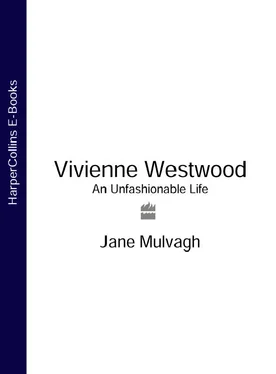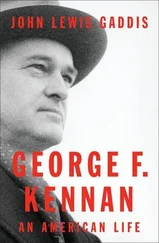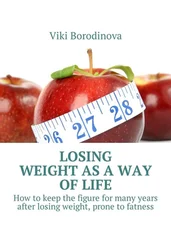Recently, one of my Central St Martin’s students, Derren Gilhouley, interviewed Vivienne for Harpers & Queen. He was struck by her assertion that ‘If I could have my time again I would be an eco warrior.’ Today we find Vivienne supporting the ideas and objectives of Noreena Hertz, the anti-globalisation campaigner and author of Silent Takeover. Perhaps grandmotherhood has inspired a greater determination in her to leave a truly worthwhile legacy for her only grandchild, Cora, of whom she is tenderly caring.
Jane Mulvagh
London, July 2003
PREFACE TO THE ORIGINAL EDITION
I first met Vivienne Westwood in the autumn of 1983, while researching my book The Vogue History of Twentieth-Century Fashion. In the two preceding years I had become accustomed to interviewing successful designers in handsome premises in the capitals of fashion. Each encounter was fairly similar. It would be formal and conducted in impressively sumptuous surroundings, with careful attention paid to the professional etiquette of sound public relations. The ritual of passing through a series of receptionists and assistants was typically followed by a one-to-two-hour conversation with the designer in his well-appointed office. Across an impressive arrangement of flowers, and against a backdrop of photographs boasting his acquaintance with the famous and the beautiful, we would discuss the motivations and influences that had formed his work.
None of this prepared me for meeting Vivienne.
Her two-room second-floor studio was squalid and cluttered. The railings up the communal outside staircase were hung with sodden, hand-dyed clothes. The entrance was blocked by half-packed boxes of late deliveries or returned orders, and the temperature inside seemed lower than the bracing October evening outside. Stepping over a collapsed ironing board and past a rickety trestle table strewn with unwashed mugs and overflowing ashtrays, I made my way to a corner where, surrounded by half a dozen ragamuffins, the designer, dressed in thick, padded, ankle-length layers of greige felted wool, nodded an informal acknowledgement.
To the hesitant tap-tap of a vintage typewriter operated by a flustered youth, we attempted to begin our interview. Pulling anxiously on a Gitane, Vivienne periodically turned to the typist and snapped, ‘Can’t you stop that noise? It’s really distracting me. I can’t think.’ The typing continued. After half an hour, during which she repeatedly lost her train of thought, she finally said, ‘Sorry, I get really bored talking about my past.’ We appeared to have reached an impasse, and I was preparing to leave when she unexpectedly turned the conversation to incest. In her latest collection she had used hieroglyphs inspired by incest and primitivism and drawn by the New York graffiti artist Keith Haring. She began to ask me questions. Were there any good books on incest? She was fascinated by it. Did I know that it was commonplace in primitive societies? She liked celebrating taboos; the unorthodox was what interested her, ‘to shock, to seduce the public into revolt’.
How had she come across Haring’s work, I asked. ‘That was my boyfriend, Malcolm,’ she beamed. Like a love-struck teenager she repeatedly mentioned Malcolm McLaren as she discussed her work, savouring the enunciation of his name. Finally, as if in confession, she bowed her head, wrung the hem of her heavy skirt between her fingers and confided, ‘I don’t live with Malcolm any more, you know. I don’t see that much of him any more, but he’s still my friend … and there we are.’ She sighed, and added in a voice choked with emotion, ‘Maybe we’ll work a little more closely in the future.’ She was clearly not seeking pity, which made her suffering all the more pitiful. I felt as if I had intruded upon a deep private grief. I was touched by her desperate anguish and her frankness to a total stranger, and could not fail to be curious about such a woman.
Over the next few years I was drawn to Vivienne’s extraordinary work, which was like no other designer’s. While others conformed to the direction that fashion was taking and tried to please the buyers, Vivienne prided herself on her almost militant resistance to orthodoxy, and had little notion of a customer. In the 1980s fashion celebrated clothes that looked rich and fast. Skirts were short, shoulders were wide, heels were high. Women strove to look hard, thin, toned, masculine, powerful and financially independent. Meanwhile, Vivienne’s idiom was the poor, the dispossessed, the anarchic. She promoted a rounded, even chubby, female shape, and dressed it in layered, baggy rags and flat shoes, such as trainers or rubber flip-flops that were fastened round the ankles with bandages. Then in an apparent volte-face , she began to produce the ‘posh’ clothes of an élite, parodying the British establishment and its uniforms of class and tradition. Through-out her creative life she irreverently snatched pieces of fashion history, inspected them, dismantled them and reconstructed them, making something modern and disturbing. As a fashion historian, it amazed me how she could extract modernity and, more surprisingly, sexiness, from a Victorian crinoline or the dowdy garb of the British royal family.
My employer at the time, British Vogue , did not like Vivienne’s earliest and most creative work. Though occasionally mentioned, she was never lauded. She was a maverick: inconsistent, uncommercial, often unwearable but, most of all, anti-establishment, and that was dangerous. Before the nineties, only her ‘Pirates’ (autumn/winter 1981–82) and ‘Harris Tweed’ (autumn/winter 1987–88) collections were extensively featured by Vogue or any other mainstream British glossy magazine; both were seen as suitably romantic, British and free of polemic. Italian Vogue , by contrast, has been consistently fascinated by her work.
Throughout the first half of the eighties, Vogue’s fashion editors were cultivating a delicate relationship with Buckingham Palace, dressing, it was assumed, the future Queen of England. Diana and Vivienne, who in her punk days had been associated with a disrespectful, not to say treasonous, attitude to the monarchy, were two images that did not sit happily together, and the magazine understandably chose to maintain its establishment connections.
But, like Diana, Vivienne is quintessentially English. She could only have emerged from a society that is, on the one hand, steeped in tradition and class deference, and on the other prides itself on being the cradle of liberalism and the tolerance – if not unduly threatened – of eccentric non-conformity and satire. Vivienne needed the taboos and rituals of this relatively small and homogeneous post-colonial society, clinging to its class system and sentimental respect for the monarchy, as a backdrop against which she could create and display her parodic pantomime of dress. Her references and the messages sewn into her clothes were full of meaning both to those who revelled in being irreverent and to those susceptible to being offended by them. The vitriol scrawled across her ‘Seditionaries’ T-shirts, the gentle irony of her Scottish tartans, royal tweeds, Henley stripes, school uniforms and hunting pinks made no sense without this social context.
Gradually, through the mid-eighties, I struck up an acquaintance with Vivienne. She came to the odd party I gave, accompanied by her teenage son Joseph, and they would always be the first to step out onto the dance floor, while other guests were still arriving. She seemed unself-conscious, even shameless, childlike yet intensely serious. Her dancing was manic; an explosion of energy in which she lost herself in a trance: a rock ’n’ roll Shaker, a punk Whirling Dervish.
Читать дальше












